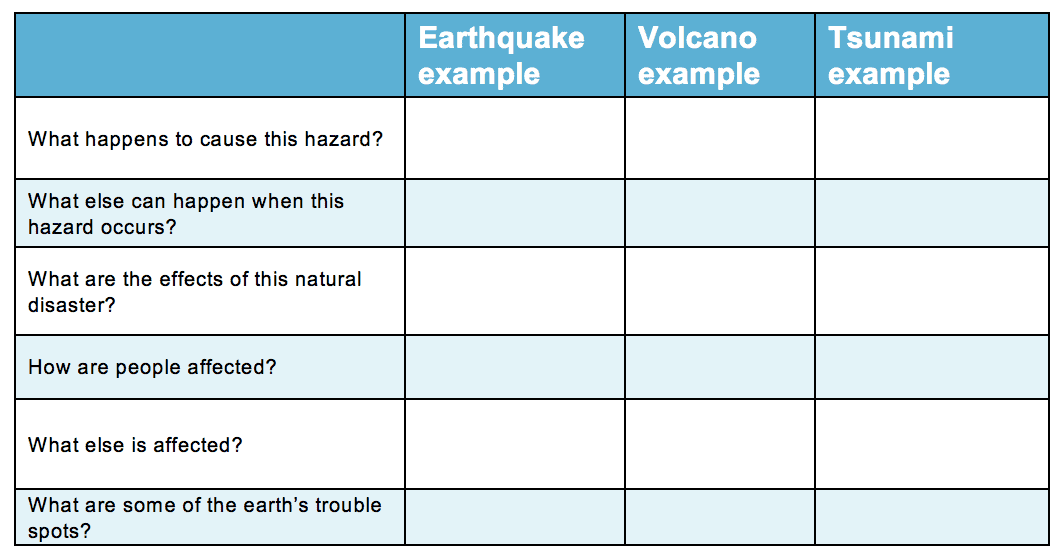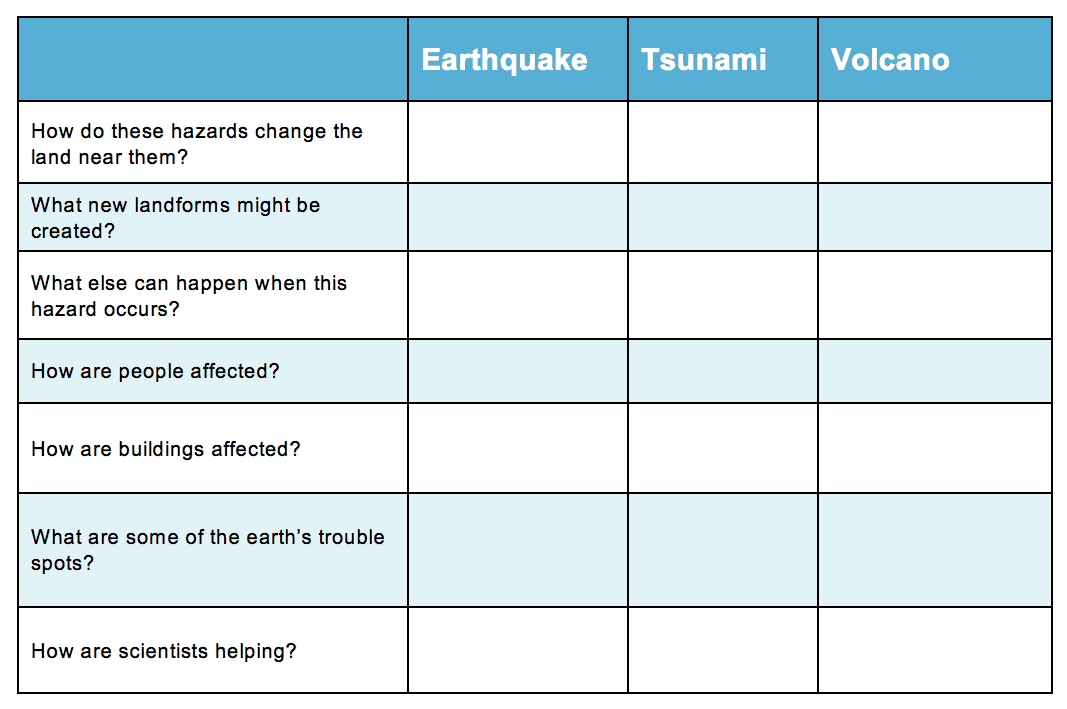Information for Teachers
Curriculum links
This investigation is linked to the following Grade 4 Next Generation Science Standards.
ESS1.C: The History of Planet Earth
Local, regional, and global patterns of rock formations reveal changes over time due to earth forces, such as earthquakes. The presence and location of certain fossil types indicate the order in which rock layers were formed (4-ESS1-1)
ESS2.B: Plate Tectonics and Large-Scale System Interactions
The locations of mountain ranges, deep ocean trenches, ocean floor structures, earthquakes, and volcanoes occur in patterns. Most earthquakes and volcanoes occur in bands that are often along the boundaries between continents and oceans. Major mountain chains form inside continents or near their edges. Maps can help locate the different land and water features areas of Earth (4-ESS2-2)
ESS3.B: Natural Hazards
A variety of hazards result from natural processes (e.g., earthquakes, tsunamis, volcanic eruptions). Humans cannot eliminate the hazards but can take steps to reduce their impacts (4-ESS3-2)
Influence of Engineering, Technology, and Science on Society and the Natural World
Engineers improve existing technologies or develop new ones to increase their benefits, to decrease known risks, and to meet societal demands (4-ESS3-2)
How to search the internet
1 Keep your request short
Fewer words will give a more accurate search.
2 Choose exactly what you want
For example: Arctic Circle Climate
3 Use quotes
Double quotes around a set of words tell the search engine to consider those exact words in that exact order without any change. For example: “Arctic Circle Climate”
4 Use the plus sign (+)
If you add a plus sign (+) between words, the internet will search for all the words. For example: migrate+birds+whales+mammal
5 Use the minus sign (–) to say what you don’t want
Use a minus sign (–) to show words you do not want to appear in your results. For example: if you search for burrowing animals and do not want mammals in your search, –mammals will exclude mammals. Note that you need to put a space before the minus sign for the word to be excluded.
6 Be very clear about what you don’t want
Part 1
Ask questions and define problems
After reading Our Moving Earth, you may have many questions about how our earth moves and what happens when it moves.
List your questions.
- Compare your list with questions that others have.
- Choose a question you would like to investigate.
- You can work alone, with a partner, or in a small group.
You may want to choose one or more of these questions to investigate
Q1. What makes up the inner structure of the earth?
Q2. How does the rock in the earth’s crust move?
Q3. What happens when the earth’s crust changes?
Q4. How are scientists trying to predict natural hazards caused by the earth’s movements?
Go to Part 2 Investigate →Part 2
Investigate
Helpful websites
You may want to use websites to help you’re your investigations.
You may want to learn more about one type of moving earth hazard. You can do a search for the name of the moving earth hazard (e.g. earthquake)+trouble+spots or earthquake+hotspots. You can search for each moving earth hazard this way.
Or you may want to learn more about the effects of this hazard by searching earthquake+effects.
Other search topics could be volcanoes+affect+people
Go to Part 3 Record data →Part 3
Record data
Find a way of recording your information that will allow you to see any patterns in the data.
Data Chart for Our Moving Earth
 Download Chart
Download Chart
Go to Part 4 Organize, analyze, and interpret data →
Part 4
Organize, analyze, and interpret data
1. Look over the information you have gathered and the patterns you have found.
How is the earth’s crust constantly changing? Why is this so?
2. Search for other patterns.
What are the most destructive natural hazards caused by the moving earth?
How is the landscape changed?
3. Makes notes about what you find.
Go to Part 5 Present and share →Part 5
Present and share
Look over all of the information that you have gathered in your investigation.
What are the most important ideas about the moving earth?
Make a chart showing the most important ideas.
 Download Chart
Download Chart
← Return to menu